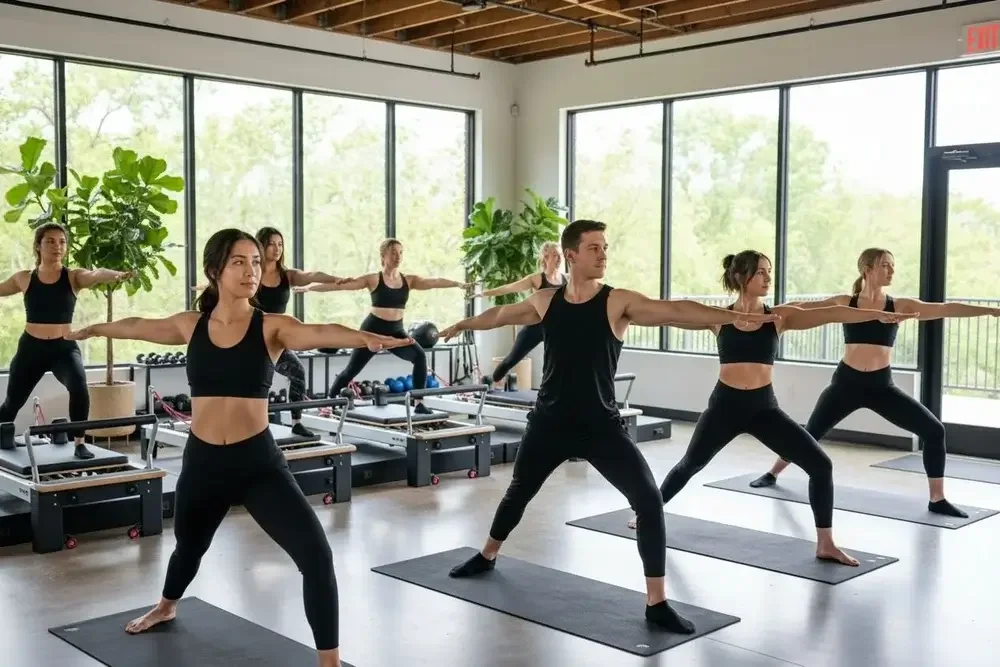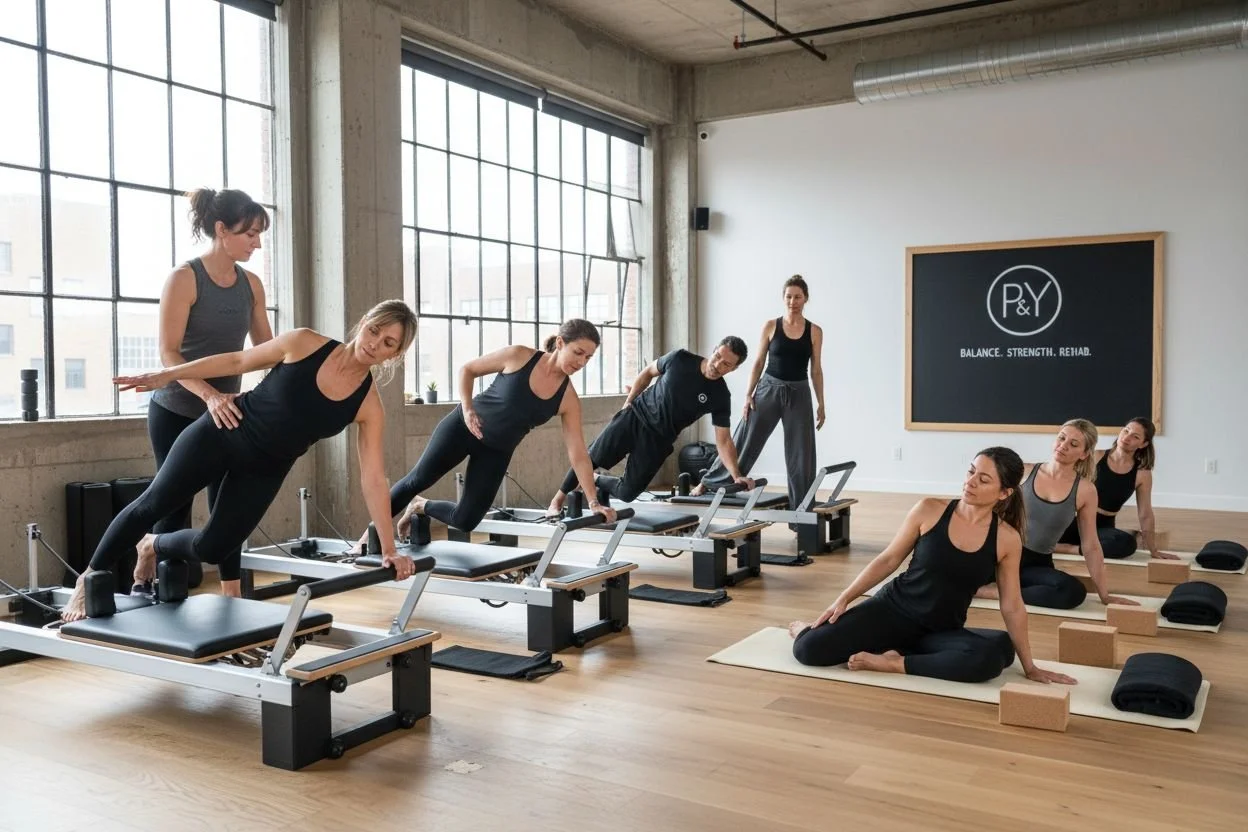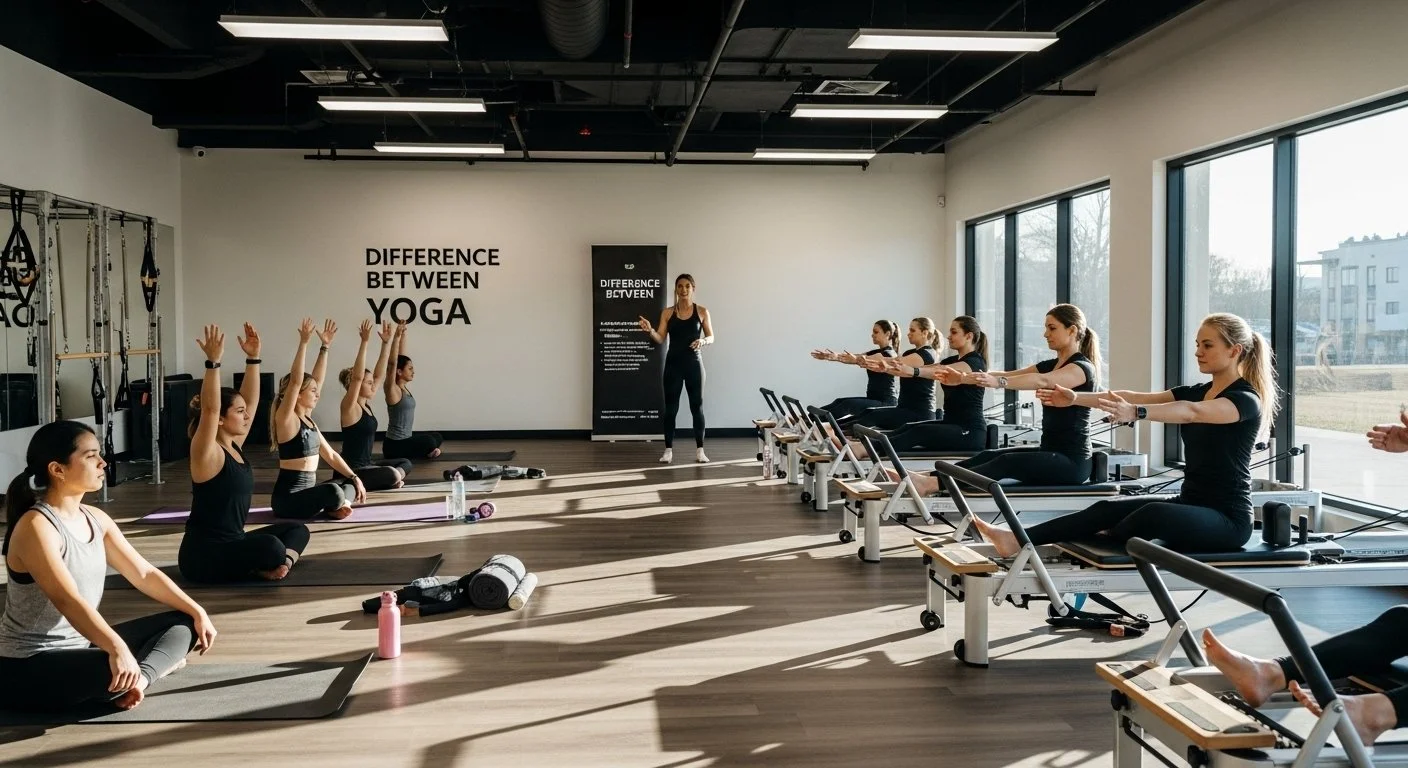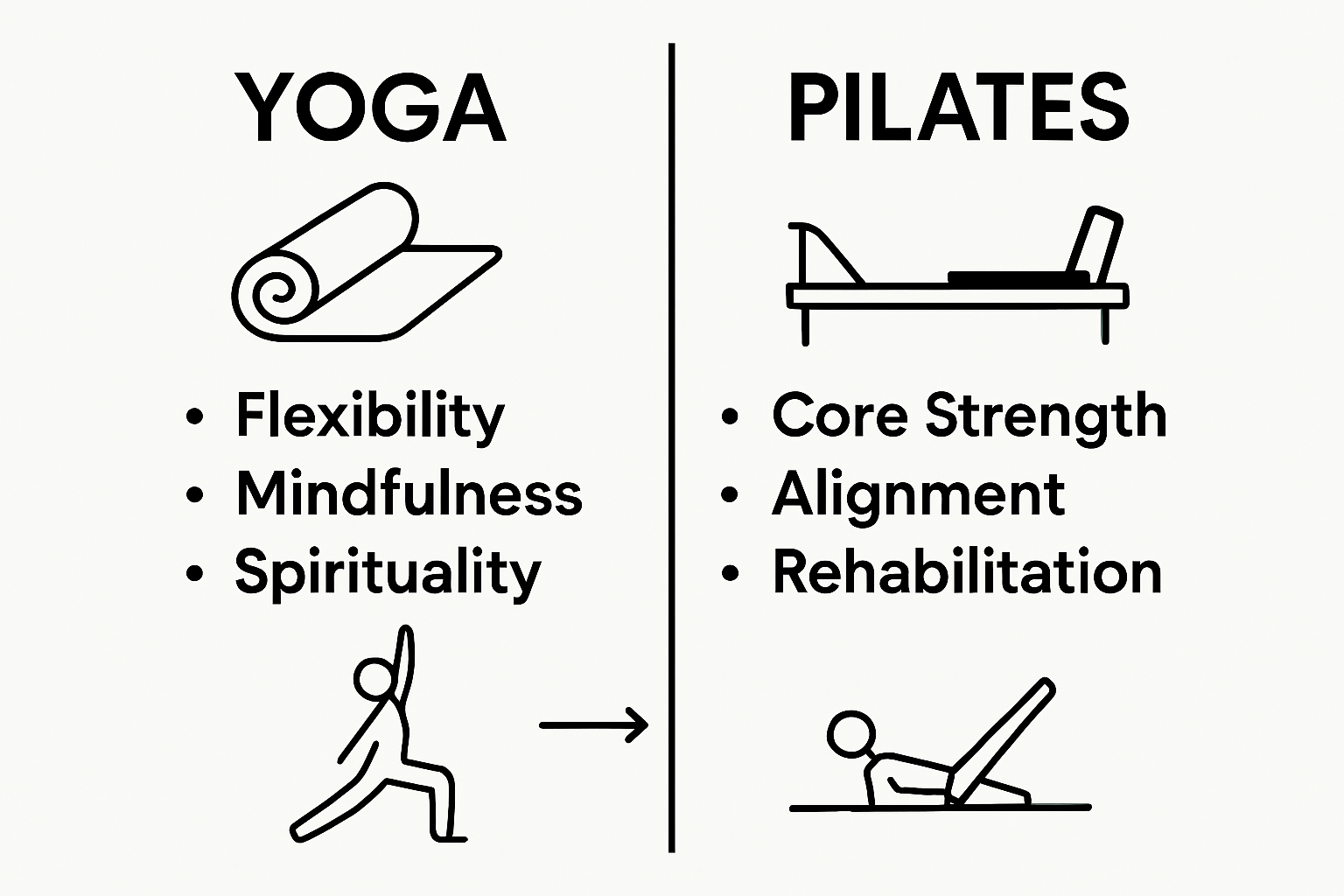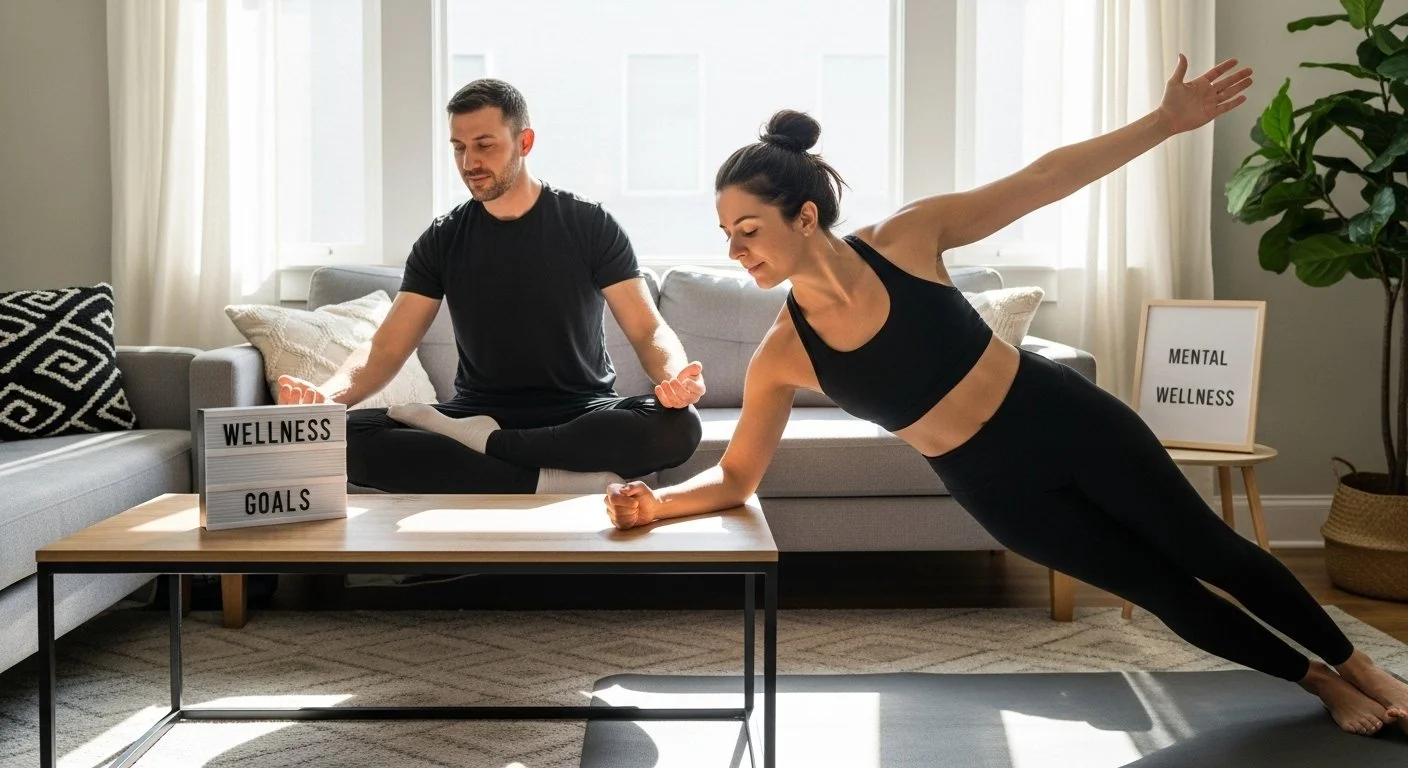Benefits of Pilates and Yoga: Complete Guide
Heather Rice
Did you know that over 36 million people in the United States practice yoga and Pilates each year? These mind-body exercises are gaining popularity for their powerful blend of strength, flexibility, and mental wellness. With a focus on breath and intentional movement, both Pilates and yoga offer unique paths to whole-body health, whether your goal is core strength, stress relief, or injury recovery.
Table of Contents
Key Takeaways
| Point | Details |
|---|---|
| Mind–Body Connection | Pilates and yoga enhance overall wellness through intentional movement and breath, targeting both physical and mental health. |
| Class Variety | Both practices offer diverse class styles suited for varying fitness levels and goals, from core strength to relaxation. |
| Physical Benefits | Pilates boosts core strength, flexibility, and balance, while yoga promotes muscle elasticity and improves posture. |
| Emotional Well–Being | These practices are effective in reducing stress and anxiety, fostering resilience through their holistic approach to mental health. |
Pilates And Yoga Defined: Core Concepts
Pilates and yoga are transformative mind-body practices that prioritize holistic wellness through intentional movement and breath. Pilates, originally developed by Joseph Pilates in the early 20th century, is a fitness system that emphasizes core strength, precise muscle control, and strategic body alignment. According to research from the National Institutes of Health, Pilates focuses on six fundamental principles: centering, concentration, control, precision, flow, and breathing.
While yoga and Pilates share similarities in their mind-body approach, they differ significantly in execution and primary objectives. Understanding the difference between Pilates and Yoga reveals that yoga traditionally emphasizes flexibility, spiritual connection, and meditative practices, whereas Pilates concentrates more intensely on physical strength, particularly core muscle development.
Key characteristics of these practices include:
Intentional, controlled movements
Emphasis on breath work
Focus on mind-body connection
Improvement of overall physical strength and flexibility
Potential for injury rehabilitation and prevention
Both disciplines offer unique pathways to physical and mental wellness, providing practitioners with comprehensive approaches to fitness that go far beyond traditional exercise routines.
Types Of Classes And Practice Styles
Pilates and yoga offer diverse class styles that cater to different fitness levels, goals, and personal preferences. According to wellness research, these practices have evolved to provide practitioners with multiple engaging workout options that target various aspects of physical and mental wellness.
In the Pilates world, practitioners can choose from several distinctive class types. 7 Reasons Why Combine Yoga and Pilates for Wellness highlights the versatility of these practices. Pilates classes typically include:
Mat Pilates: Foundational body-weight exercises focusing on core strength
Reformer Pilates: Utilizing spring-loaded equipment for resistance training
Tower Pilates: Incorporating apparatus with springs and straps for advanced movements
Barre Pilates: Fusion of Pilates and ballet techniques for comprehensive toning
Yoga offers an equally rich landscape of practice styles. Research indicates multiple approaches that serve different wellness objectives:
Hatha Yoga: Physical-focused practice emphasizing basic postures
Ashtanga Yoga: Structured, progressive sequence of movements
Power Yoga: Strength-building dynamic practice
Vinyasa/Flow Yoga: Energetic, movement-linked breathing technique
Iyengar Yoga: Precision-based practice utilizing props
Hot Yoga: Intense, heated session promoting flexibility and detoxification
Restorative Yoga: Gentle, relaxation-oriented practice
Yin Yoga: Long-held poses targeting deep connective tissue flexibility
Whether you're seeking intense physical training or meditative relaxation, these diverse Pilates and yoga styles offer something for every wellness journey.
Here's a comparison of common Pilates and yoga class types and their main focuses:
Pilates and Yoga Class Types
| Class Type | Primary Focus | Equipment/Setting |
|---|---|---|
| Mat Pilates | Core strength Body control |
Mat only |
| Reformer Pilates | Resistance Postural alignment |
Reformer machine |
| Tower Pilates | Advanced strength Flexibility |
Tower apparatus |
| Barre Pilates | Toning Balance |
Barre Small props |
| Hatha Yoga | Foundational poses Relaxation |
Mat only |
| Power Yoga | Strength Cardio |
Mat only |
| Restorative Yoga | Stress relief Gentle movement |
Mat Bolsters Props |
| Vinyasa/Flow Yoga | Dynamic movement Breathwork |
Mat only |
Physical Benefits For Strength And Flexibility
Pilates and yoga offer transformative physical benefits that go far beyond traditional exercise routines. A comprehensive 2023 systematic review revealed that these practices significantly improve overall body functionality, targeting multiple aspects of physical wellness through intentional movement and controlled breathing techniques.
In the realm of strength development, Pilates stands out as a particularly powerful practice. Master Aerial Yoga Flexibility Exercises for Mobility demonstrates how these practices build comprehensive body strength. Research indicates that Pilates specifically enhances:
Core muscle stability
Overall muscular strength
Postural alignment
Balance and coordination
Muscular endurance
Flexibility is another critical benefit of these practices. Unlike traditional strength training, Pilates and yoga simultaneously improve muscle elasticity and joint mobility. By incorporating controlled, deliberate movements, practitioners can expect:
Increased range of motion
Reduced risk of injury
Enhanced muscle lengthening
Improved overall body mechanics
Better respiratory function
What makes these practices truly unique is their holistic approach to physical conditioning. They don't just build muscles—they create a harmonious connection between strength, flexibility, and mindful movement, offering a comprehensive approach to physical wellness that traditional gym workouts often miss.
Mental Health And Stress Reduction Advantages
Mind-body practices like Pilates and yoga offer profound mental health benefits that extend far beyond physical exercise. A systematic review reveals these practices are powerful interventions for managing stress, anxiety, and overall emotional well-being through intentional movement and breath work.
The psychological advantages of these practices are remarkable. 7 Examples of Mindfulness Practices for Better Health highlights how these techniques can transform mental landscape. Research indicates these practices specifically contribute to mental health by:
Reducing symptoms of anxiety and depression
Enhancing emotional regulation
Building social connectedness
Improving overall stress management
Creating a sense of community through group practice
At the core of these benefits is the mind-body intervention approach, which integrates physical movement with mental focus. By synchronizing breath, movement, and awareness, practitioners develop a unique toolkit for emotional resilience. The meditative aspects of Pilates and yoga encourage practitioners to be present, cultivate inner calm, and develop a more balanced perspective on life's challenges.
Unlike traditional exercise, these practices offer a holistic approach to mental wellness. They don't just provide physical relief but create a profound connection between body and mind, offering a comprehensive strategy for managing stress, enhancing emotional intelligence, and promoting overall psychological health.
Injury Recovery, Posture, And Mobility Support
Pilates and yoga offer remarkable therapeutic benefits for individuals seeking injury recovery, improved posture, and enhanced mobility. Research demonstrates these practices are not just exercise routines, but sophisticated rehabilitation strategies that address complex physical challenges through targeted, controlled movements.
In the realm of injury recovery, these practices shine particularly bright. 7 Essential Yoga Poses for Beginners to Get Started illustrates how mindful movement can support healing. Scientific reviews indicate these practices specifically support rehabilitation by:
Enhancing core muscle recruitment
Improving spinal stability
Developing muscular and neural control
Increasing overall flexibility
Supporting chronic pain management
The biomechanical approach of Pilates makes it particularly effective for posture correction and mobility enhancement. By emphasizing precise movement, breath control, and muscular engagement, these practices help realign the body, reduce structural imbalances, and create more efficient movement patterns. This makes them invaluable for individuals recovering from injuries or managing chronic physical limitations.
Unlike traditional rehabilitation methods, Pilates and yoga offer a holistic approach that addresses not just physical symptoms, but the underlying movement patterns that contribute to pain and dysfunction. By integrating strength, flexibility, and body awareness, these practices provide a comprehensive pathway to recovery, improved posture, and long-term physical resilience.
How To Choose The Right Class For You
Selecting the perfect Pilates or yoga class can feel overwhelming with the numerous styles and approaches available. Your personal fitness goals, current physical condition, and desired outcomes are crucial factors in making the right choice for your wellness journey.
Yoga for Beginners in Philadelphiasuggests understanding your primary objectives is the first step in class selection. For those seeking specific outcomes, consider these targeted approaches:
Pilates Class Selection:
Mat Pilates: Ideal for beginners, focuses on foundational strength
Reformer Pilates: Offers resistance training for advanced practitioners
Tower Pilates: Provides challenging equipment-based workouts
Barre Pilates: Perfect for dance-inspired toning and flexibility
Yoga Style Recommendations:
Hatha Yoga: Best for beginners, gentle introduction to poses
Power Yoga: Recommended for strength and intense workouts
Restorative Yoga: Excellent for relaxation and stress relief
Vinyasa Flow: Great for those seeking dynamic, continuous movement
The key is matching your personal fitness level, physical limitations, and wellness goals with the right practice. Whether you're recovering from an injury, looking to build strength, or seeking mental clarity, there's a Pilates or yoga style perfectly suited to your needs.
Experience the Transformative Benefits of Pilates and Yoga with Amrita Yoga & Wellness
If you are looking to build core strength, improve flexibility, or reduce stress while cultivating mind-body balance, our tailored Pilates and yoga classes at Amrita Yoga & Wellness are designed for you. This complete guide highlights key challenges such as injury recovery, posture improvement, and mental health support all addressed through intentional movement and breath control. Whether you want to start gently with Hatha Yoga or dive into the strength-building benefits of Reformer Pilates, we have options that meet your personal wellness goals.
Join a community that helps you connect more deeply with your body and mind right here in Philadelphia. Don’t wait to experience the comprehensive benefits outlined in this article that go beyond typical workouts. Explore all our offerings and sign up for classes, workshops, or retreats at Amrita Yoga & Wellness. Discover your perfect class and start your journey to better strength, mobility, and mental clarity today by visiting our class schedule and details. For beginners, check out our guide to beginner yoga classes and take the first step toward lasting wellness now.
Frequently Asked Questions
What are the main benefits of practicing Pilates and yoga?
Both Pilates and yoga enhance physical strength, flexibility, and improve mind-body connection. They also contribute to mental health benefits, such as stress reduction and emotional regulation.
How do Pilates and yoga differ in their approach to fitness?
Pilates primarily focuses on core strength, muscle control, and body alignment, while yoga emphasizes flexibility, spiritual connection, and meditative practices. Each discipline offers unique pathways to wellness.
Can Pilates and yoga help with injury recovery?
Yes, both Pilates and yoga offer therapeutic benefits and support injury recovery by enhancing core muscle recruitment, improving spinal stability, and increasing flexibility, making them effective rehabilitation strategies.
How do I choose the right Pilates or yoga class for my needs?
Consider your fitness goals, current physical condition, and desired outcomes. Beginners might benefit from Mat Pilates or Hatha Yoga, while more advanced practitioners may prefer Reformer Pilates or Power Yoga.
